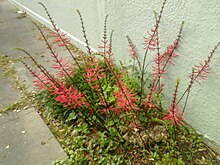
Back حمرية أمريكية Arabic Erythrina americana AST Erythrina americana CEB Erythrina americana Spanish فردوسی آمریکایی Persian Erythrina americana French Tzompancuahuitl NAH Эритрина коралловидная Russian Erythrina americana Swedish Erythrina americana Vietnamese
| Erythrina americana | |
|---|---|

| |
| Flowers | |
| Scientific classification | |
| Kingdom: | Plantae |
| Clade: | Tracheophytes |
| Clade: | Angiosperms |
| Clade: | Eudicots |
| Clade: | Rosids |
| Order: | Fabales |
| Family: | Fabaceae |
| Subfamily: | Faboideae |
| Genus: | Erythrina |
| Species: | E. americana
|
| Binomial name | |
| Erythrina americana | |
| Synonyms[1] | |
|
Corallodendron americanum (Mill.) Kuntze | |
Erythrina americana (coral tree, colorines, colorín, or pemoches), is a flowering plant of the genus Erythrina which is native to Mexico. Colorín (plural colorines) is the name of a type of tree, Erythrina americana also called Tzompāmitl. The word colorín means color chillón—a “gaudy” or “loud” color (Williams 1959).
Colorines plant also called, cuchillitos (little knives) or machetitos (little machetes), zompantle, or coral is a nice flower, red in color and every individual flower resembles a little machete, the flower is edible[2] and is boiled (only the red part of the flower) and cooked with scrambled eggs or tuna in many parts of south Mexico.

This variety flowers during the dry season (April) in many parts, and the plant is very popular with hummingbirds because of the bright red color, the plant ranges from a few feet off the ground to trees five meters tall.
The earliest depiction of this tree in America is in the Florentine Codex. In the 17th century, Francisco Hernández commented: "The juice from the flowers of this tree, given to children induces drowsiness and sleepless".[3]
Other sites explain that although the flower is edible,[4] the seeds and everything else in the tree is highly toxic, in Mexico, the pulverized seeds are used as rat poison and the bark is used as fish poison.[5]
- ^ "Erythrina americana Mill. — The Plant List". theplantlist.org. The Plant List. Retrieved 4 September 2016.
- ^ "Cocinando Flores de Colorín – Carlos Lázaro". vivedeviaje.com.mx. Archived from the original on 2016-09-18. Retrieved 4 September 2016.
- ^ "Zompantle o colorín (Erythrina americana Miller). Tlahui - Medic No. 20, II/2005". tlahui.edu.mx. Retrieved 4 September 2016.
- ^ "La Jornada Morelos en Internet". Archived from the original on 2014-04-07. Retrieved 2014-04-05.
- ^ Tull, Delena (1 January 1999). Edible and Useful Plants of Texas and the Southwest: A Practical Guide. University of Texas Press. ISBN 9780292781641. Retrieved 4 September 2016 – via Google Books.